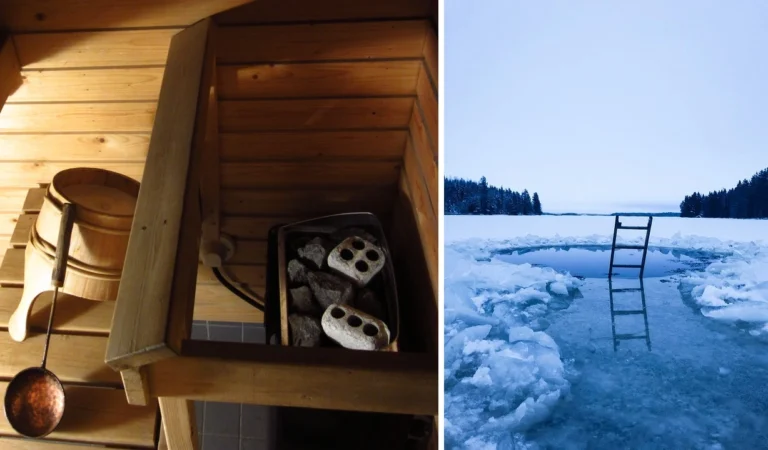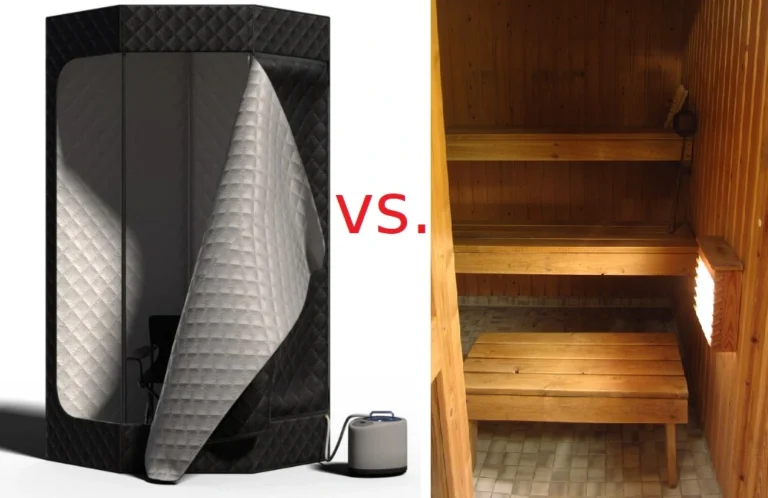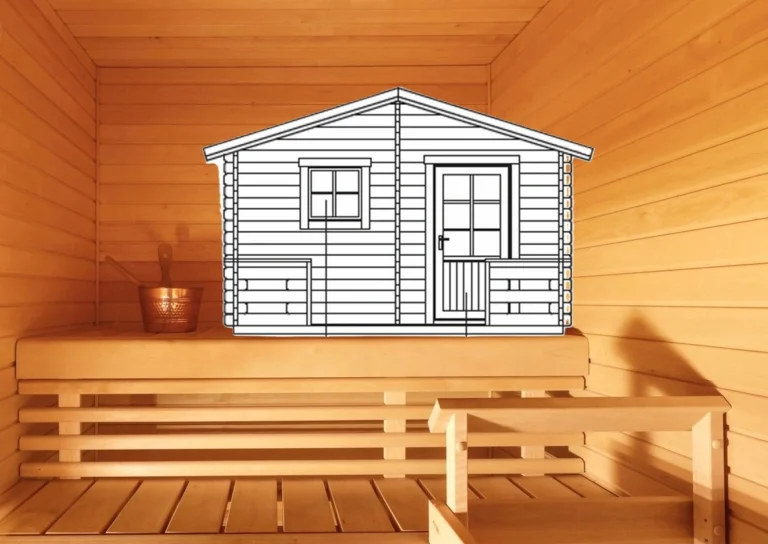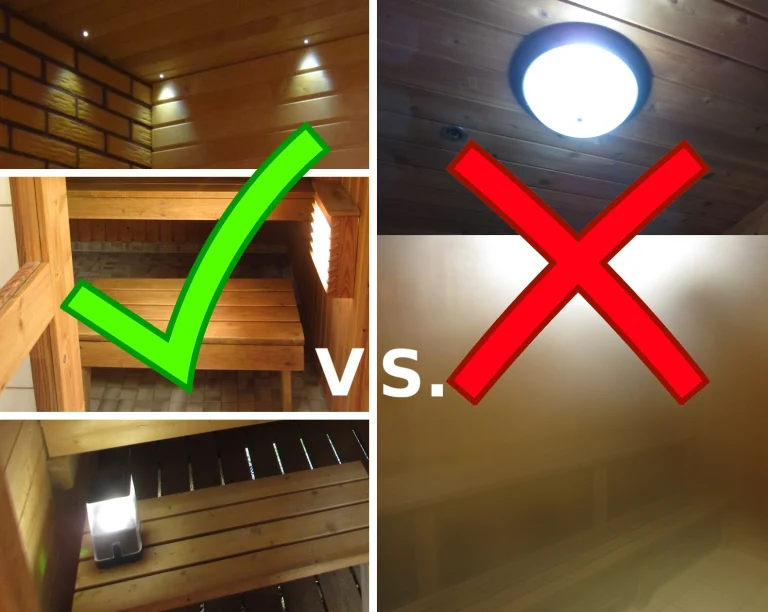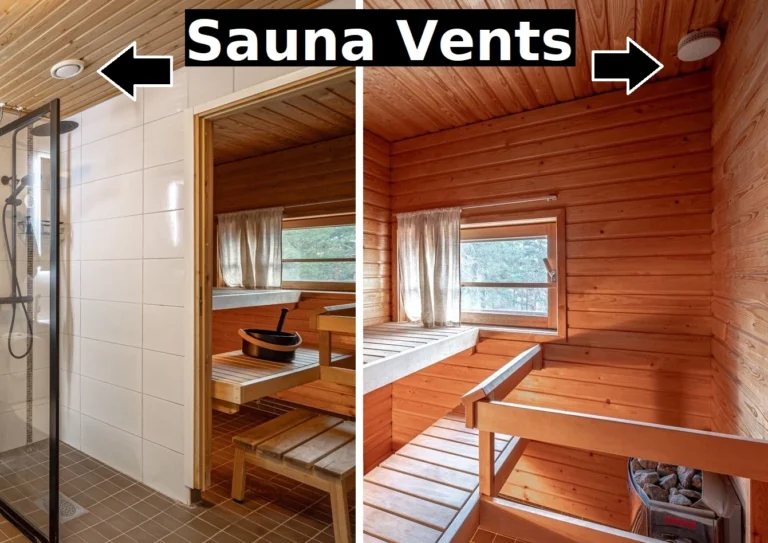Sauna Whisk: 7 Tempting Reasons to Get Whipped in a Sauna
Have you ever wondered what are the leaves in a sauna you see in many sauna ads and pictures?
And if you’ve seen what people DO with those leaves, you might’ve asked the inevitable: why do people whip themselves in the sauna?
Well, today I’ll answer those questions and show you how to make your own sauna whisk!
That’s exactly what sauna leaves are called: a sauna whisk, less commonly a bath broom (vihta or vasta in Finnish, depending on which side of the country you live in).
Let’s see what leaves are used in whisks, why, what their purpose and benefits are, how to make your own whisk, and where to find one if you can’t make your own.

What Are the Benefits of a Sauna Whisk? 7 Reasons to Get Whipped in a Sauna
Firstly, what leaves do you use in a sauna? Although you can choose leaves from oak, juniper, or eucalyptus, the most popular and traditional leaves by far come from birch.
Secondly and most importantly, what is the purpose of a sauna whisk?
1. Cleansing effect
Birch leaves contain saponin that functions as a mild soap that helps cleanse your skin gently, removing grease and dirt.
2. Aromatherapy
What gives birch leaves such a pleasant scent is the essential oil they naturally contain.
When you bring a (freshly-made) birch whisk to your sauna, even on its own it spreads a lovely scent to the entire space, but it gets even stronger when you start using the whisk.
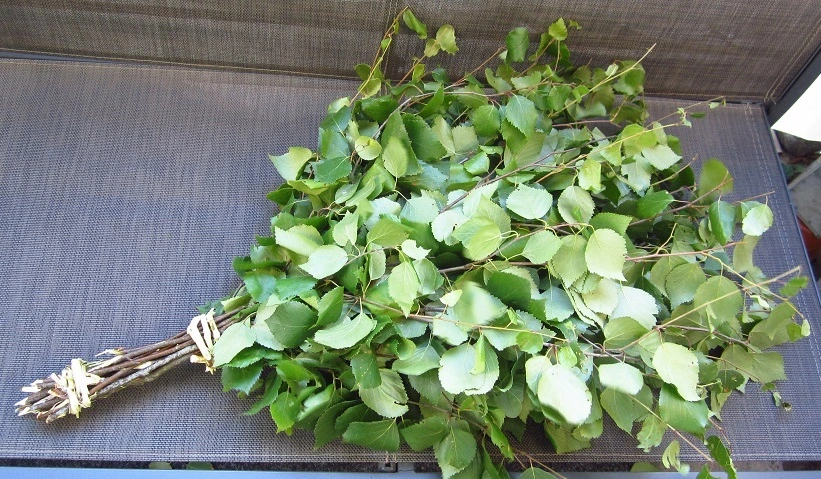
3. Fights inflammation
It’s the oil in birch leaves that fights inflammation. That’s because birch (oil) is bactericidal (= bacteria-killing), and has anti-inflammatory, antiviral, and wound-healing properties.
When whisking your skin with birch leaves briefly in a sauna, it’s not the same as topically applying birch extract to your skin, but it still goes to show what a powerhouse birch is.
4. Improves circulation
Why do you hit yourself with leaves in a sauna? It’s a type of massage that improves circulation and accelerates metabolism.
Juniper offers a rougher and more “scratchy” treatment than birch, which a minority of people prefer, and therefore also stimulates circulation more effectively than birch.
You can also mix leaves, using mostly birch and adding only few juniper branches. This way you can get the best of both worlds without the whisk becoming too rough.
5. Relieves pain
If you have aches in you body, let’s say neck, shoulder, and/or back pain, for instance, hitting those areas with a warm sauna whisk in a hot, steamy sauna brings heat directly to those areas, improving circulation which helps carry healing nutrients to aching tissues.
In old times, people with rheumatic pains used to hit themselves with sauna whisks made entirely of nettle (!). Some people still do this, but always at their own risk.
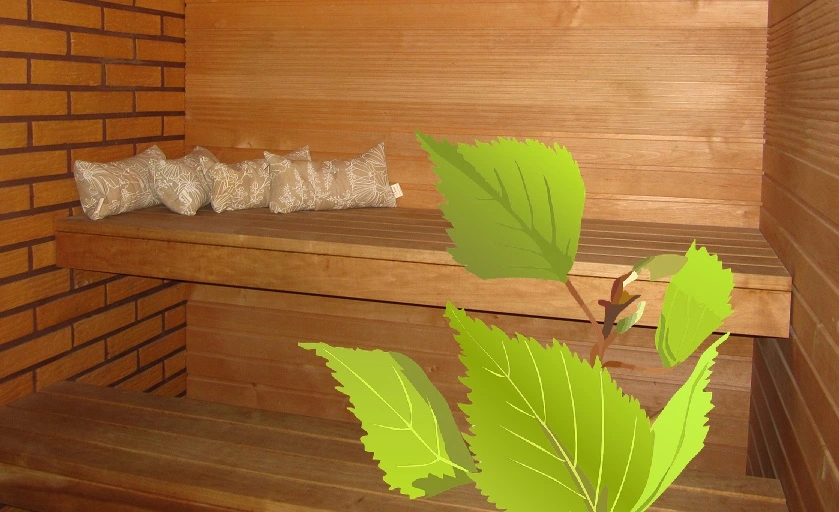
6. Peels off itchy, dead skin cells
Saunaing helps peel dead skin cells off, which whisking only emphasizes.
If you have oily skin, an oak whisk is most effective at treating it.
7. Post-sauna relaxation
Most people who regularly use sauna whisks don’t do so for the cleansing effect alone, for instance, but because it feels so good overall during saunaing, and leaves you feeling super relaxed.
This is especially the case when you have someone else whisking your back properly, typically using more force than you’re capable of using yourself since it’s difficult to reach your own back.
How to Use a Sauna Whisk/Bath Broom
This is easiest to show in video format:
So, how to use sauna leaves? “Spank yourself with branches,” is the answer they provide in the video, which is correct! Whipping yourself with a sauna whisk is definitely no rocket science:
✅ In general, you can whip yourself anywhere you like except for face and head.
✅ If possible, always ask a friend or a family member to whip your back; while it’s easy to slap yourself with the whisk using it on the front side of you body, you can’t reach your back nearly as well.
✅ While you can certainly whip your arms and legs (particularly if you have aches and pains and would like to improve your circulation in those areas), it doesn’t have quite the effect that whipping larger surfaces has.
✅ Mostly you see people whisking themselves in their midsection, both front and back. It just feels better and more holistic than whipping your limbs.
Pro tip: most people prefer gentler whipping on the front of the body and rougher whipping on the back; when you feel a pleasant pinch after each slap on your back, that’s what many people are after, and that’s when your circulation improves the most and you also feel the most relaxed and calm after your sauna session.

How to Activate a Dried Whisk
A freshly-made whisk is ready to use right away, but when using a dried whisk, let it soak first in a bucket full of lukewarm water for 1 to 2 hours.
If you’re pressed for time, you can use warmer (not hot) water for a shorter period of time.
Take the whisk with you to sauna in a washbowl that you’ve filled with fresh, warm water. After use, rinse the whisk gently with cold water and let it dry in a cool, dark, and airy space.
Pro tip: You can use the birch water (soaking water) as your sauna water that you throw on the hot sauna rocks! It’s visibly greenish and infused with birch, enhancing the aromatherapeutic effect of your sauna session.
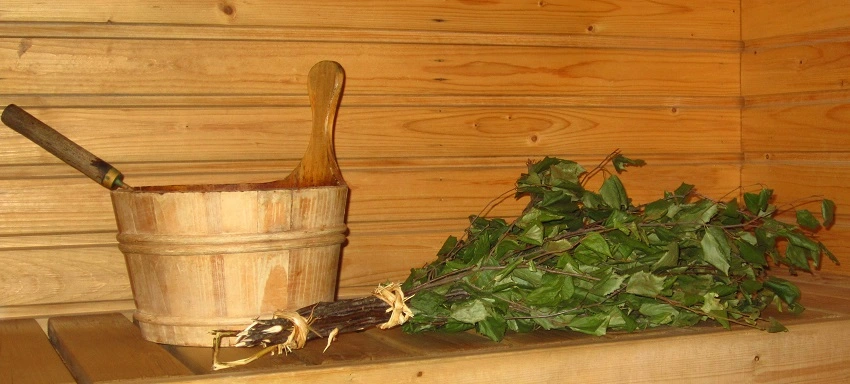
How to Make a Sauna Whisk
Nowadays many people don’t have the energy and know-how to make traditional whisks, so they just tie the branches using store-bought string, possibly even plastic one (it’s counterproductive as a whisk is ideally fully biodegradable, which plastic obviously isn’t).
A traditional sauna whisk is made of 100% birch, which means that no kind of string, wire, or rope is used to tie the whisk. Instead, you make the “string” yourself from a birch branch, officially called a withy.
I wanted to both show how to make a traditional whisk and make one myself, so I followed the best video instructions below.
The woodworker in the video offers the clearest instructions: he shows two ways of making a whisk (tying with a “string” as you go OR making a band which you adjust). I used the first method, so that’s the one I’m also sharing here.
There’s almost no talking in the video, which really allows you to look at the action:
Written instructions:
➊ Have permission to use the branches you cut.
➋ Make the “string” out of a birch branch by scratching the surface with a knife; sharpen the outer end (it’s going to make tying easier).
➌ Soften the “string” by twirling it –> this breaks the rigid structure and allows the branch to become bendy; you shouldn’t hear any crackling when twirling.
➍ Stack up the branches, leaving the underside of the leaves upwards; strip off all leaves from the handle.
➎ After stacking up 15 branches, turn the whisk over and add another 15 branches, once again the underside of the leaves upwards.
➏ Tie the whisk as shown in the video; the key is to twist the string constantly, otherwise it’ll snap; repeat for the remaining end of the handle.
➐ Trim the branch ends, making sure your thighs and knees are a safe distance away from your knife blade.
➑ Using leftover string, keep twisting it and make a hanging loop.
Now you should have a beautiful, immediately ready-to-use sauna whisk!

Practical Tips
🌿 It’s totally okay to make a smaller, shorter, narrower, or bushier whisk, according to your own preferences.
🌿 If you’ve found the perfect branches and have already prepped them, but aren’t able to make the string (withy) yourself, just use store-bought string and call it a day! It’s not the end of the world.
🌿 What matters the most is quality branches and leaves; if you cut branches from an old birch tree, you may find them droopy, the leaves can have small holes and some even insects’ eggs (!) glued to the underside, and birch catkins may be present (they shouldn’t).
🌿 If you don’t have quality materials, and cut or rip all the “bad parts” off, it’s a lot of extra work and mess, and won’t help since you’ll be left with sparse and limp branches.
Frequently Asked Questions (FAQ)
1. Sauna whisk near me?
Below you can see you have a good chance of getting birch leaves (betula) if you live in the north (source: Wikipedia):

Just remember that you either need the landowner’s permission to cut birch branches or you have to own the property yourself.
2. Artificial sauna whisks, are they any good?
I’ve seen plastic and crochet sauna whisks on the market.
With them, the user experience is nothing like with the original; the plastic ones get so hot they can burn your skin, and the crochet ones can get so floppy and heavy, especially when wet, that it’s better to use them dry.
They can still have their place. Some people are allergic to birch, and artificial whisks also last a lot longer while natural ones are perishable and biodegradable.
3. How long does a sauna whisk last?
It’s realistic to expect to get a few uses out of a traditional whisk.
Once the leaves really start crumbling and falling out, then it’s time to discard the whisk. Remember that it’s pure biowaste, meaning it’s ideal for composting.
If you have a wood-burning sauna stove, you can use your old whisk as kindling the next time you heat up your sauna.

4. What is a sauna whisk called? Is it vihta or vasta?
Both are correct. In Western Finland, they say vihta whereas in Eastern Finland, they prefer vasta. This is because Finnish has several regional dialects.
5. I don’t have any birches in my area. Where to buy a sauna whisk?
The best options are Amazon and other online stores.
Sauna whisk prices seem pretty consistent, varying between $20 and $25 for one whisk. When the price is significantly higher, the package usually contains several whisks.
When buying sauna leaves, remember to double-check you’re getting birch leaves (not maple, for instance) if a traditional whisk is what you’re after.
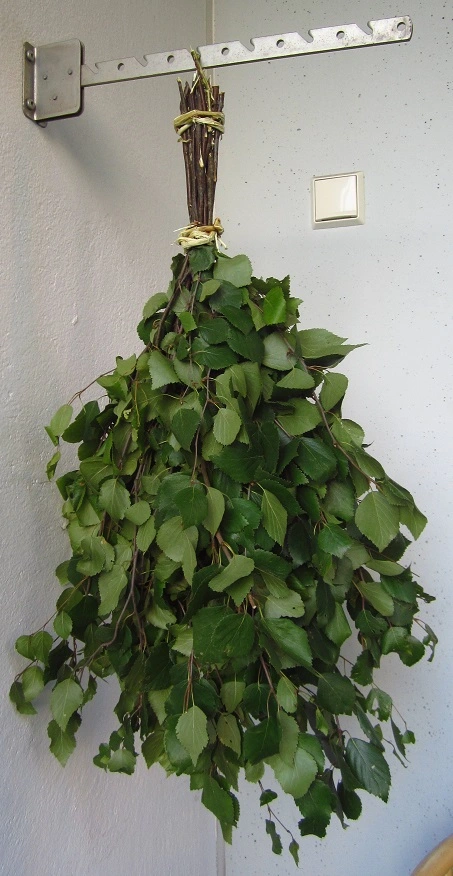
Final Thoughts
As this article grew a lot longer and detailed than I initially anticipated, I guarantee you now know more about sauna whisks than many Finnish people do!
But if you already forgot some of the points, no worries: just know that a sauna whisk enhances your sauna experience overall, making it even more enjoyable and relaxing.
Let’s conclude with interesting language trivia related to sauna whisking.
You may have heard that Finnish has dozens of nouns for different kinds of snow (which is true), but Finnish also has a lot of specific sauna vocabulary.
You can say “to slap yourself (or a fellow sauna-goer) with a whisk in a steamy sauna” with only one verb, either vihtoa or vastoa.
These verbs have very pleasant, relaxing, and even sacred connotations, unlike the English versions (hit, slap, whip, and spank) that we’re forced to use since nothing better is available.
So, please don’t be fooled by the negative expressions, but instead, embrace the whisking!

